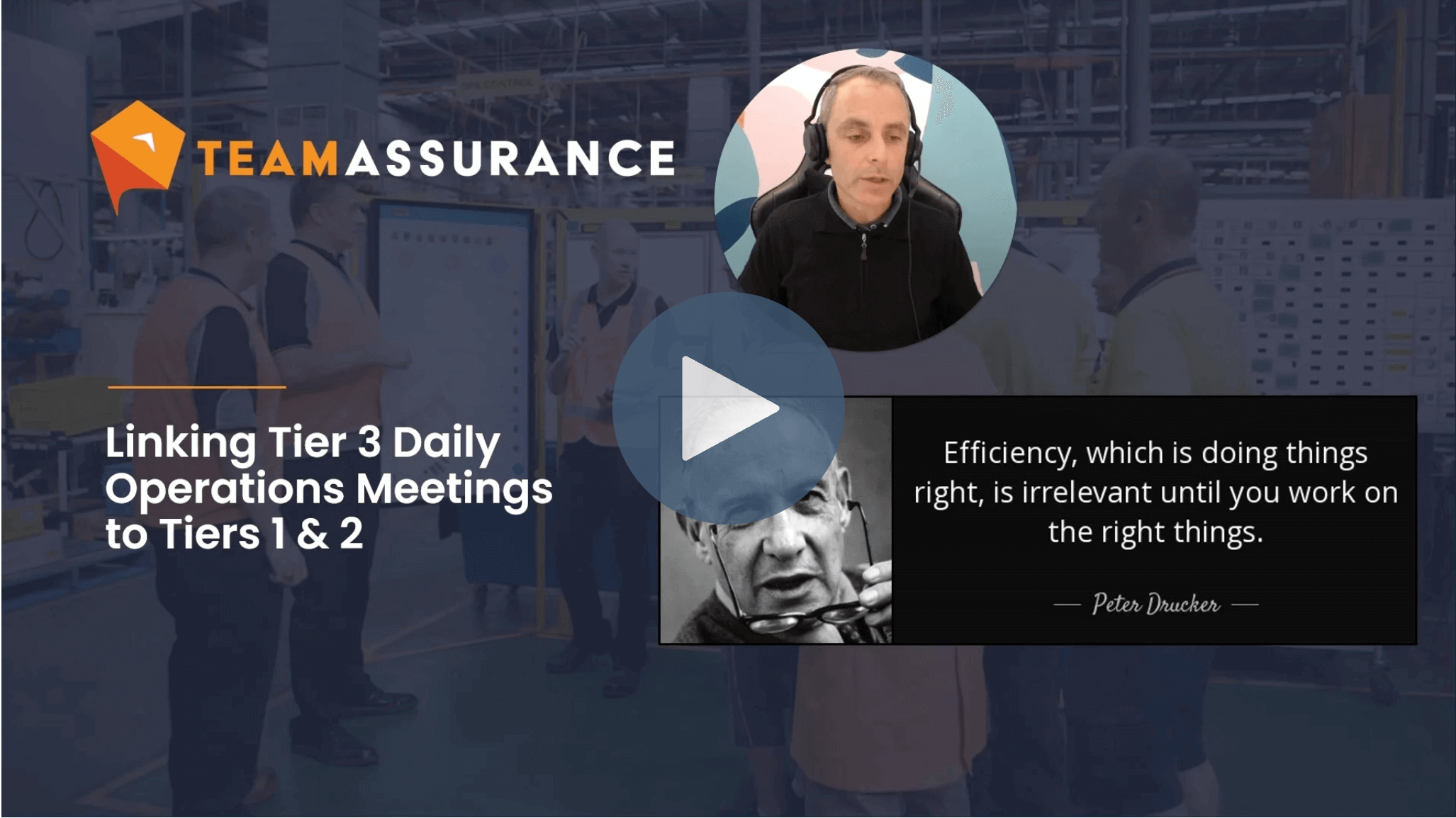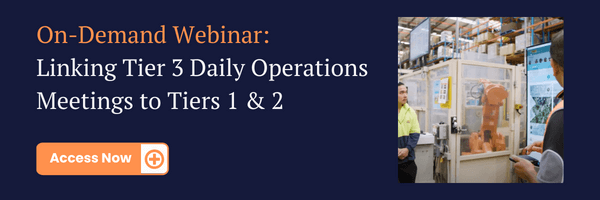In this article we summarise the key points from our webinar on integrating tier 3 daily operations meetings seamlessly. Want to watch the webinar on-demand? Click right here.
The Importance of Efficiency and Working on the Right Things
In the ever-evolving landscape of business operations, the quest for efficiency and effectiveness remains at the forefront. It’s a concept well-articulated by the esteemed Peter Drucker, who famously highlighted the distinction between the two. Efficiency, in its essence, involves doing things right, while effectiveness is about doing the right things.
This principle is particularly pertinent to the operational dynamics of organizations, where the alignment of day-to-day tasks with overarching strategic goals is crucial.
Efficiency, in its essence, involves doing things right, while effectiveness is about doing the right things.
Peter Drucker
Efficiency is not merely about speed or precision in isolation; it’s about ensuring that every action taken and every resource expended brings you closer to your strategic objectives. In the context of organizational operations, this translates to a tiered structure of management and execution.
Here, the tiers are not just levels of hierarchy but are integral components of a cohesive strategy that ensures every team member, from the frontline to senior management, is working on the right things.
Where Tier 3 Daily Operations Meetings Fit
The tiered approach to operational management demarcates clear roles and responsibilities across three distinct levels:
Tier 1 is the foundation – it represents the frontline executors.
Tier 1 are the individuals on the ground, turning strategy into action. Their efficiency lies in their ability to perform tasks accurately and promptly, but their effectiveness is inherently tied to the clarity of the directives they receive and the relevance of their tasks to the organizational goals.
Tier 2 acts as the pivotal bridge.
This layer is tasked with 2 key roles. i) translating high-level strategy into actionable plans for Tier 1, and ii) owning and improving the function’s key systems/process standards. They also play a critical role in feeding back information from the frontline to inform strategic adjustments, embodying the dual principles of efficiency and effectiveness through continuous refinement and alignment.
Tier 3 is the apex, it is where strategy is conceived and culture is defined.
This tier sets the overarching goals and values that guide the organization, focusing on long-term vision and the resolution of chronic problems. The effectiveness of Tier 3 is measured by its ability to steer the organization towards its strategic objectives while fostering a culture that values and pursues efficiency and effectiveness at all levels.
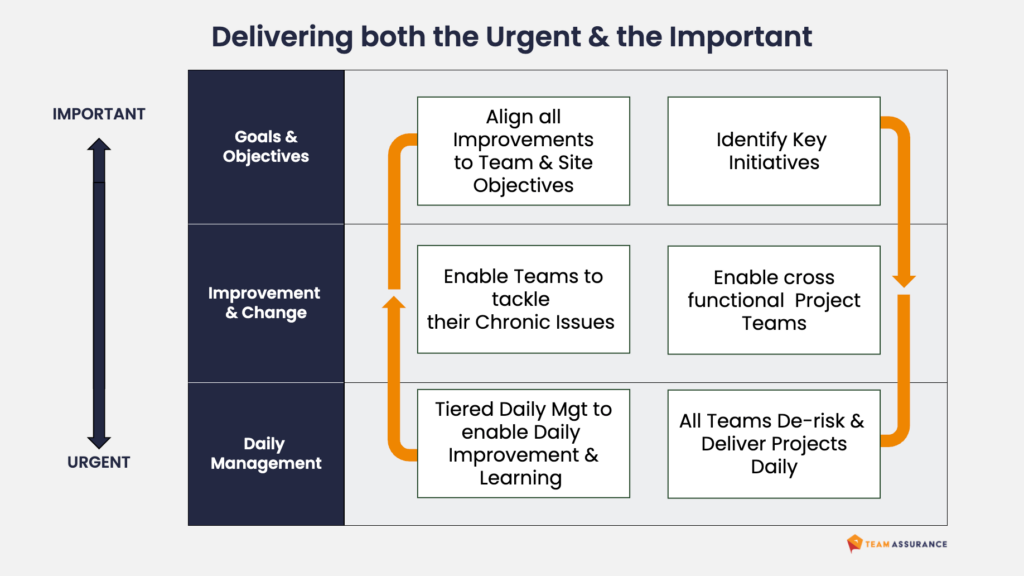
Understanding the interplay between these tiers is essential for achieving operational excellence. It’s not enough for each tier to operate efficiently in isolation; they must also work effectively in concert. This ensures that every action at every level is aligned with the strategic objectives of the organization.
The important AND the urgent tasks are therefore worked on by the best people for the task. Simultaneously, at speed and at scale.This holistic approach to operational management is what distinguishes truly successful companies in today’s competitive landscape.
Leveraging Technology for Streamlined Daily Operations Meetings
The strategic integration of technology within organizational operations is not merely an advantage; it’s a necessity. This integration plays a pivotal role in connecting the various tiers of an organization, enhancing communication, decision-making, and overall efficiency.
The implementation of TeamAssurance exemplifies how technology can bridge the gap between strategic planning at Tier 3 and execution at Tiers 1 and 2.
These platforms facilitate real-time communication, allowing for immediate feedback and agile adjustments to operational strategies. Moreover, they enable the capturing and analysis of data from frontline activities, providing leadership with insights that are critical for informed decision-making. Leaders have a big job, and a big area to cover so give them a fighting chance to be effective.
Leaders have a big job, and a big area to cover so give them a fighting chance to be effective.
Matt Mafrici – Linking Tier 3 Daily Operations to Tier 1 & 2 Webinar
By harnessing the power of technology, organizations can achieve a level of operational fluidity that was previously unattainable. The ability to quickly disseminate strategic changes, monitor their implementation, and gather feedback in real-time creates a dynamic environment where continuous improvement is not just possible but ingrained in the organizational culture.
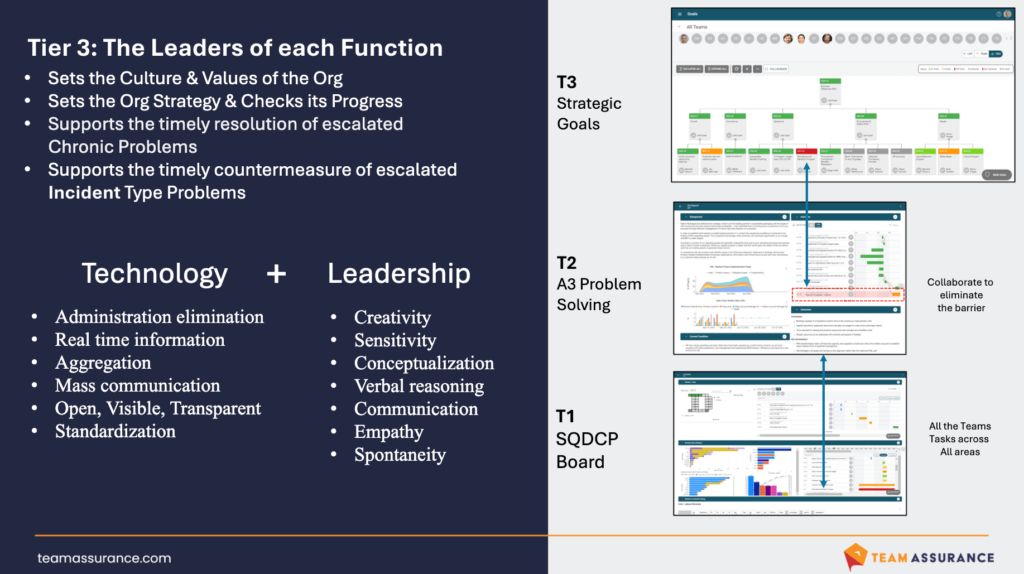
This approach not only streamlines operations but also ensures that the entire organization is aligned and moving cohesively towards common goals.
In essence, technology serves as the conduit through which Tier 3’s strategic vision is transformed into actionable tasks at Tier 1 and 2, thereby fostering a culture of efficiency, responsiveness, and innovation. Utilize technology in support of good leadership, not as a replacement.
2 Key Considerations When Linking In Tier 3
Tier 3 daily operations meetings must connect with Tiers 2 and 1 with ‘clear intent’. That means taking a dedicated and structure approach to implementation. There are two key elements to achieving this:
1) Define your values and culture before you start to engage with tier one and two. Your actions at the managerial level inherently define the values and expected behaviours of the entire organisation.
2) Use an omni-directional, ‘top-down and bottom-up’ process when deploying strategy. Everyone contributing and connected to the strategy is the only way to ensure sustained success. It enables incremental, high-velocity continuous improvement. Focused on the right things with agility rather than sluggish, ‘one and done’ step-change improvement activities.
When you get this right for Tier 3, like Drucker said – you’re not just helping everyone be efficient but you’re focusing everyone on right things!
Viewing Daily Operations Meetings as part of the greater C.I. Framework
Daily operations meetings aid in the alignment of our people, processes and systems. They are, however, just one part of a much larger continuous improvement framework. Other Lean practices like standardised problem solving techniques, Standard Operating Procedures (SOPs), and PDCA cycles are also key to achieving success over both the short and long term.
The illustration below shows how we designed the TeamAssurance platform to avoid locally-optimised, or isolated ‘Point Solutions’ (digital or analog) that can hinder alignment and progress towards the organisation’s goals.
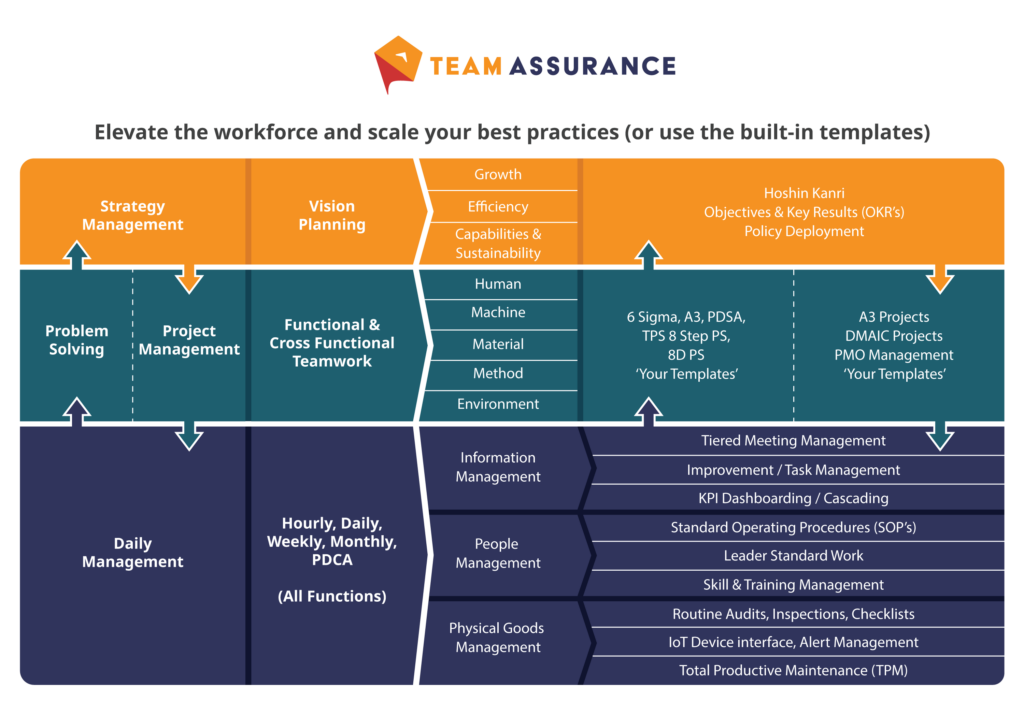
If you’re a business in need (or a consultant with clients in need)speak to use about the opportunities that digital-aids to Lean tools provide. Contact us for a demonstration of the TeamAssurance platform today

